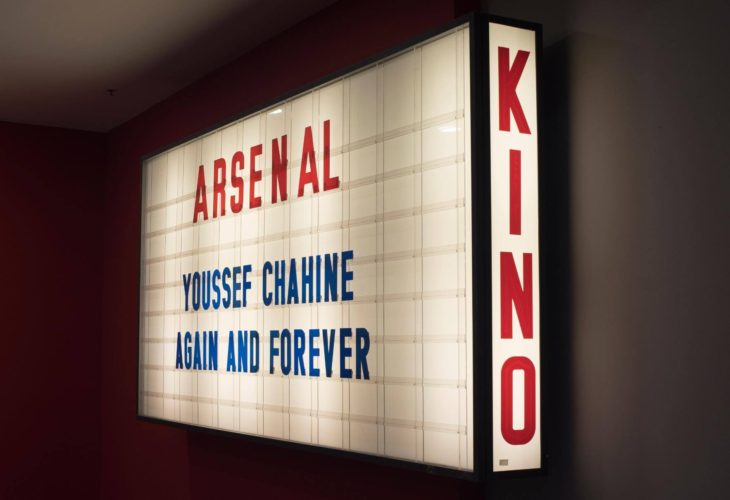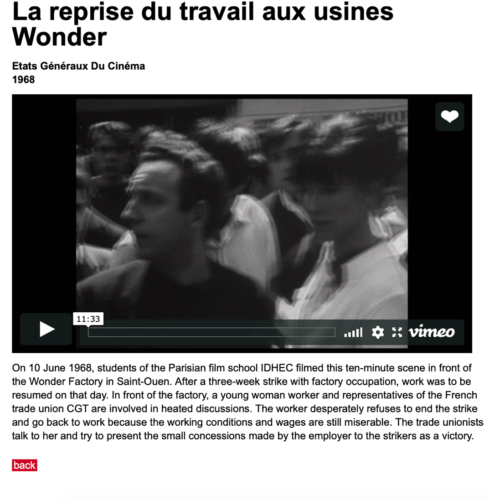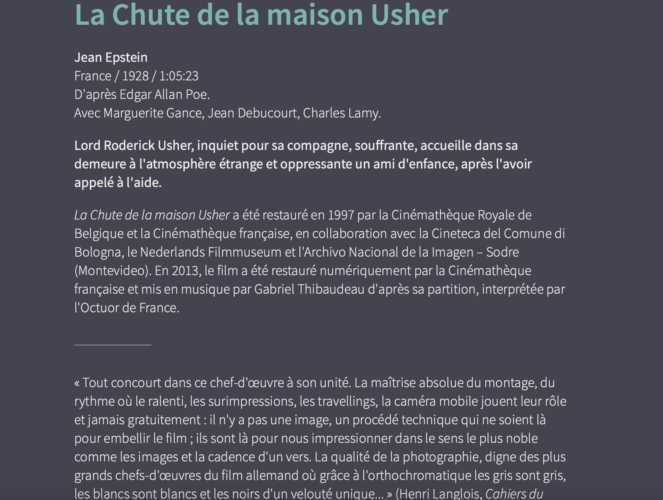During the isolation due to the pandemic, many online film archives have not only been made accessible for free, but also put forward a new mode of curating art. Unlike the traditional cinematheque with an actual room, curating films online has to be attractive for a bigger global audience that is interested in discovering rare and hard-to-find footage. Yet this audience is also harder to pinpoint with clarity. Similar to posting on Facebook, to curate online is an increasingly difficult job because one does not know who they are really addressing, and more importantly, why one speaks to a specific audience.
From my experience of browsing during isolation, the selection and presentation of films at the online cinematheque is rather traditional. The targeted audience seems to be the same as before, that is, the public that goes to see films in the traditional room for old films. Like the cinematheque, either the theme or the director has to spark interest in the online event. For example, some archives, like Arsenal 3 Berlin, gives one access to certain films that are selected according to a theme for two weeks. While in isolation, during weeks 7 and 8 (7&8 collection) the chosen theme is work and labor strikes. Other archives, like the French online cinematheque Henri, added a film each evening, and the films are organized either by director or by the production studio and the genre of the avant-garde film.
In presenting archival films, one faces two obstacles. First, online archives are made to incite one to buy subscriptions, or to physically go to the film rooms to watch them. Call it however you like, hook, teaser, or anything else, but online archives are not independent sources of cinematic archives.
The archives advertise themselves as such. Henri tells us that it represents the fourth room of the cinematheque, until the others will open up, while Arsenal 3 asks for money to fund the first two rooms, Arsenal 1 and 2, as well as the artists who hold the copyrights for the films. There are a lot of explanations for why this happens. In addition to the fact that archives need to self-promote their content, films ca be streamed for free only if the artists agree to it (if the films are out of copyright, they can be screened without asking for the consent of a third party). This is why the selected films on Henri are made before 1945, such as the avant-garde silent films Albatros studio collection(1919-1929). At Arsenal, the state of affairs is not necessarily better off, although the collection 7&8 seems to be extended from the 1960s to today.
If the archives are a teaser, then their primary function is not to offer a general access to films, but to incite the public to either buy bigger subscriptions or donate money. Any selection of films is placed in a broader process by which the public is encouraged to invest time and money in the materials that the archive offers. What I mean to say is that I do not ask, for example, that Arsenal 3 becomes an anti-Netflix platform in the way it interacts with the public. I do not think one should claim that they should act like this, given the lack of a 100% funding from the German state. But what one can ask the Institute for Film and Video Art archive is to make the access to the films compatible with the anti-capitalist message of many of their film productions. Arsenal 3 could be, at least partially, an online independent archive that would function like Ubuweb, which has sustained itself exclusively from the consent of the artists who agreed that the films can be screened for free. If streaming all their films for free is not an option for Arsenal 3, then one option could be a monthly selection, for instance, that would give free access to some films in the archive. The selection would maintain a high level of interest in their archive, not just temporarily, due to the necessity of self-isolation during the lockdown. Online curating that will put films for free on the internet would have the mission to not only attract specialists to the archive, but also to grant a broader public the access to the Institute’s films, which otherwise will remain buried and uninteresting.
The second observation will address the format of the introductory texts which represent the primary interface between the curator and the potential interest of the visitor. In the online archives, the text seems to be rather aimed at the archival process instead of arousing the interest of people who want to see the film.
The basic problem with the archives is that they are look too much like archives, to put it this way. They have more the format of a classical library, and less of user-friendly sites that describe one why one should watch a film. Usually, libraries present a card with a film synopsis, and this card is what usually convinces the viewer to watch the film. Same goes for the online cinematheque. The synopsis-like texts are usually more addressed to the archival researcher, rather than a wider public that is interested in films.
For instance, for Arsenal 3, the introductory texts seem to describe the content of the film in the manner of a so-called objective review. For a film such as La reprise de travail aux usines Wonder the text is descriptive, without providing any justifications for why it would be worthwhile to watch it.
There are exceptions, however, when the viewer is encouraged to think about a provocative issue. The introduction to Harun Farocki’s film, In comparison, describes the director asking viewers to compare the manufacturing process of bricks in traditional societies, pre-industrial and industrial. But most of the time the texts look like an ordinary library card description.
Henri’s strategy is somehow different. The chosen angle to introduce films is the cinematic technique, and this should be the entry gate into why the film was selected to begin with. The investigation of the technique reels in the viewer with the provocative text of a film critic. For instance, in introducing The Fall of the House of Usher, we are told that the director, Jean Epstein, has absolute control of the montage, on the rhythm and of the ralenti (in the words of Henri Langlois). The art of cinematography is the chosen standpoint to encourage watching, for instance The Mirror with Three Faces, where the critic describes how the director has complete control over the technique.
But if the cinematic technique is a good angle to convince a group of specialists, there is still the matter of the wider audience that are only vaguely interested in silent films. How can this public be jolted, provided that one watching films on your phone is now a possibility? Can the specialized language bring more visitors to an online archive?
The issue highlighted by the online curatorial work is that the archive was made for specialists, but it now must function according to a different media setting. The online format changes the conditions of interacting with the archive, which should not retain the traditional model of archiving footage.
A seductive example of an archive that I like is a site such as Monoskop, which offers multiple references to a name, an artistic orientation, or an art object (as far as I know, the site is maintained by one person, on a shared site with Ubuweb). The site is not simply an archive that was made to be accessible for a short time, but one that is made to function and be used for years to come. Let’s say, for instance, that Arsenal 3 would like to become an archive like Monoskop. This would make possible the comparison and contrast of Harun Faroki’s film (In comparison, collection 7&8), with another film that references it, such as Harun Farocki Zweimal (from collection 5&6). In online curating, the films should not be simply put on display because of the feeling of global desperation, but rather they should be connected by appealing to strategies to make them exciting. The larger issue is that, in comparison with Monoskop, online archives like Arsenal 3 or Henri are not only designed to cater to experts in the field, but also to generate revenue. Even so, to select and broadcast films online from time to time does make them more appealing and increase the public interest for analog films.
The big question for presenting an online archive is not how to show off a collection of rare gems (or films that hard to find for a certain number of specialists). The issue is how to bring a bigger number of people to watch certain films while convincing them that this is worth their while. To achieve this, opening up archives to a free-for-all format is the key because it would begin the process of reaching a public that is generally hard to reach.





Comments are closed here.